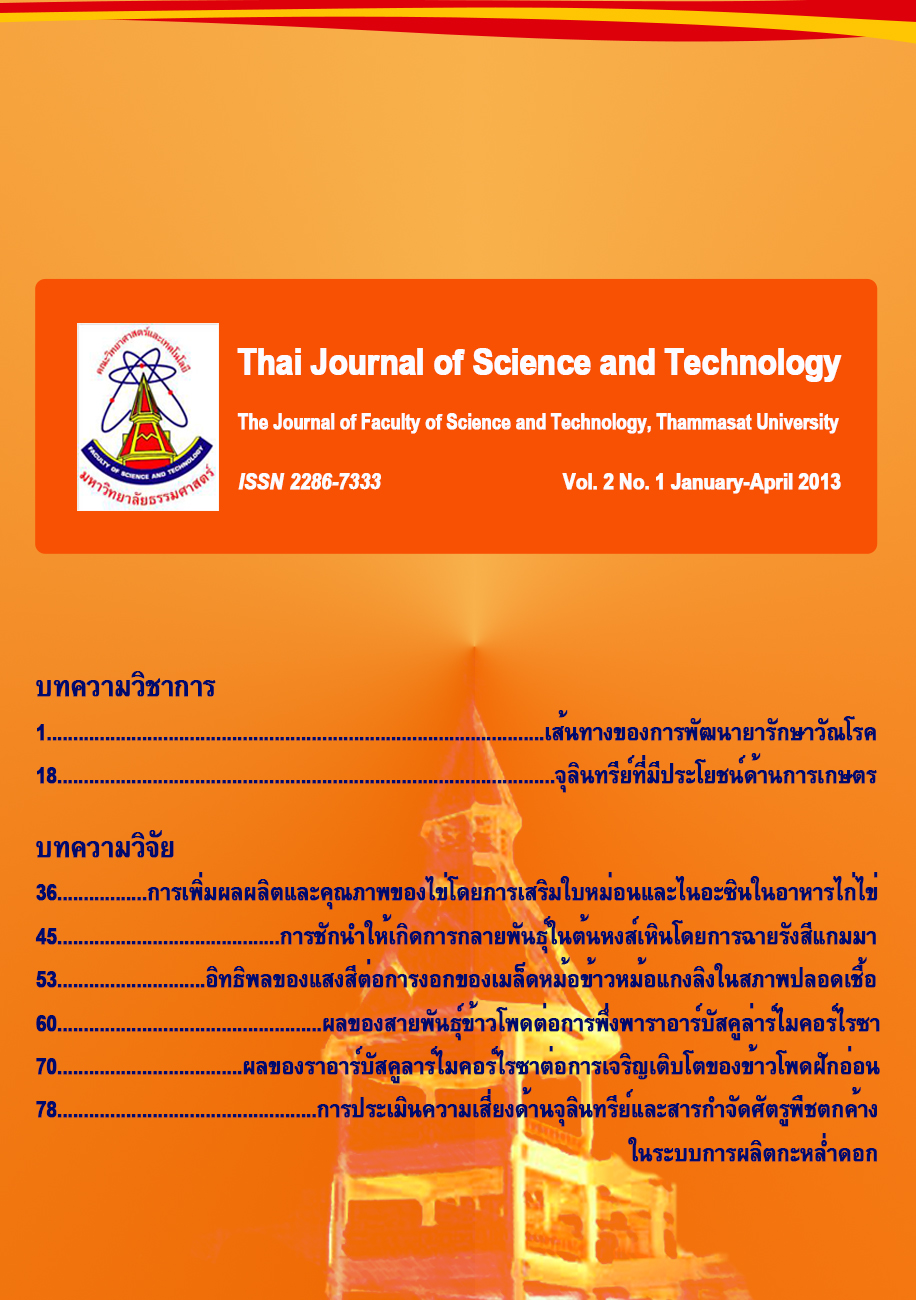การประเมินความเสี่ยงด้านจุลินทรีย์และสารกำจัดศัตรูพืชตกค้างในระบบการผลิตกะหล่ำดอก
Main Article Content
Abstract
บทคัดย่อ
การใช้แบคทีเรียปฏิปักษ์ 2 สายพันธุ์ คือ Pseudomonas fluorescens SP007s และ Bacillus licheniformis SP009s เพื่อควบคุมโรคเน่าเละที่เกิดจากแบคทีเรีย Pectobacterium carotovorum subsp. carotovorum โดยการคลุกเมล็ดร่วมกับการพ่นใบด้วยแบคทีเรียปฏิปักษ์แต่ละสายพันธุ์ และปลูกเชื้อสาเหตุโรคเน่าเละให้ต้นกะหล่ำดอกในสภาพเรือนทดลอง พบว่าแบคทีเรียปฏิปักษ์ทั้ง 2 สายพันธุ์ สามารถเพิ่มการเจริญเติบโตของต้นกล้า และลดการเกิดโรคเน่าเละได้ 66 ถึง 84 % เมื่อเปรียบเทียบกับวิธีการไม่ใช้แบคทีเรียปฏิปักษ์และในสภาพไร่ พบว่ากรรมวิธีที่ประสบผลสำเร็จในการควบคุมโรค ได้แก่ การคลุกเมล็ด และพ่นใบพืชด้วยแบคทีเรียปฏิปักษ์ SP007s 4 ครั้ง เมื่อพืชอายุ 14, 28, 42 และ 56 วันหลังปลูก มีประสิทธิภาพในการส่งเสริมให้กะหล่ำดอกเจริญเติบโตและได้ผลผลิตเพิ่มขึ้น 57 % อีกทั้งยังลดความรุนแรงของโรคเน่าเละ เน่าดำ (เกิดจากแบคทีเรีย Xanthomonas campestris pv. campestris) และใบจุดอัลเทอร์นาเรีย (รา Alternaria sp.) ได้ 77.6, 82.3 และ 84.5 % ตามลำดับ ซึ่งแตกต่างทางสถิติจากแปลงปลูกที่ไม่ใช้แบคทีเรียปฏิปักษ์การประเมินความเสี่ยงของการใช้แบคทีเรียปฏิปักษ์ต่อชนิดและปริมาณของแบคทีเรียในระบบการผลิตกะหล่ำดอก พบว่าประชากรแบคทีเรียบริเวณรอบรากพืชหลังเก็บเกี่ยวที่อายุ 65 วัน ได้แก่ Pseudomonas, Bacillus, Corynebacterium และ Serratia มีจำนวนเปลี่ยนแปลง และ/หรือ เพิ่มขึ้น 1-2 เท่า ซึ่งตรงข้ามกับ Pectobacterium ที่มีจำนวนลดลงจากระยะก่อนปลูกพืช ยิ่งไปกว่านั้นการเพิ่มปริมาณดีเอ็นเอในบริเวณยีน hrcN ด้วยไพรเมอร์จำเพาะภายใต้ปฏิกิริยาลูกโซ่พอลิเมอเรส พบว่า SP007s ไม่มียีน hrcN ที่เกี่ยวข้องกับการทำงานของ ATPase ในระบบ type III secretion ซึ่งจำเป็นต่อการก่อให้เกิดโรค ตลอดจนแบคทีเรียสายพันธุ์นี้ไม่ก่อให้เกิดปฏิกิริยาเซลล์ใบยาสูบตายอย่างเฉียบพลัน ผลการทดลองเหล่านี้แสดงว่า P. fluorescens SP007s ไม่ใช่เชื้อสาเหตุโรค สำหรับการตรวจวิเคราะห์สารกำจัดศัตรูพืชที่อาจตกค้างในกลุ่มออร์แกโนฟอสเฟต (โพรฟีโนฟอส) และกลุ่มไพรีทรอยด์ (ไซเพอร์เมทริน) พบว่ากะหล่ำดอกทุกตัวอย่างทดสอบไม่มีสารกำจัดศัตรูพืชทั้ง 2 ชนิด ตกค้าง งานวิจัยนี้จึงบ่งชี้ให้เห็นว่าการใช้แบคทีเรียปฏิปักษ์สายพันธุ์ SP007s หรือ SP009s ร่วมกับสารกำจัดศัตรูพืชอย่างเหมาะสมมีศักยภาพที่จะนำไปใช้เป็นการควบคุมทางเลือกหรือลดการใช้สารเคมีเพื่อการผลิตกะหล่ำดอกเชิงการค้าได้ดีอย่างชัดเจน (P = 0.05)
คำสำคัญ : Pseudomonas fluorescens; Pectobacterium carotovorum subsp. carotovorum; ระบบ type III secretion; โพรฟีโนฟอส; ไซเพอร์เมทริน
Abstract
Bacterialantagonists, Pseudomonas fluorescens SP007s and Bacillus licheniformis SP009s were studied for biological control against cauliflower soft rot caused by Pectobacterium carotovorum subsp. carotovorum. All antagonists significantly enhanced seedling growth and decreased disease severity from 66 to 84 % compared to non-treated control. Under field conditions, seed treatment plus foliar spray with SP007s 4 times at 14, 28, 42 and56 days after planting significantly promoted plant growth with 57 % yield increase, and decreased severity of soft rot, black rot (caused by Xanthomonas campestris pv. campestris) and Alternaria leaf spot (Alternaria sp.) of 77.6, 82.3 and 84.5 %, respectively. Risk assessment of bacterial antagonists used in cauliflower production for bacterial community impact revealed the rhizosphere populations from soil of plant grown for 65 days including Pseudomonas, Bacillus, Corynebacterium and Serratia populations were either constant and/or increased 1-2 folds, while Pectobacterium decreased from the initial cultivation. Moreover, the type III secretion system with the ATPase encoding gene hrcN necessary for bacterial pathogenicity was determined by PCR that the hrcN amplicon has not been found in SP007s. This strain also could not induce hypersensitive response on tobacco. These results indicate that SP007s is not a pathogen. Moreover, pesticide residues analysis including organophosphate (profenofos) and pyrethroid (cypermethrin) groups was investigated. The result revealed that all pesticides were not detected in each cauliflower samples. Results suggested that cauliflower production system using SP007s or SP009s and suitable pesticide has the potential for use in commercial field application as alternative control or reduced pesticide use.
Keywords: Pseudomonas fluorescens; Pectobacterium carotovorum subsp. carotovorum; type III secretion system; profenofos; cypermethrin
Article Details
บทความที่ได้รับการตีพิมพ์เป็นลิขสิทธิ์ของคณะวิทยาศาสตร์และเทคโนโลยี มหาวิทยาลัยธรรมศาสตร์ ข้อความที่ปรากฏในแต่ละเรื่องของวารสารเล่มนี้เป็นเพียงความเห็นส่วนตัวของผู้เขียน ไม่มีความเกี่ยวข้องกับคณะวิทยาศาสตร์และเทคโนโลยี หรือคณาจารย์ท่านอื่นในมหาวิทยาลัยธรรมศาสตร์ ผู้เขียนต้องยืนยันว่าความรับผิดชอบต่อทุกข้อความที่นำเสนอไว้ในบทความของตน หากมีข้อผิดพลาดหรือความไม่ถูกต้องใด ๆ


